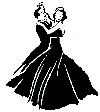 |
ROUND DANCING — CHOREOGRAPHED BALLROOMEDUCATIONAL ARTICLESMAJOR SECTIONS: Figures | Articles | Links | Alph. Index | Search | Home |
|
|
WALKINGby Harold & Meredith Sears Almost everyone responds to music. When you hear a catchy tune with a clear beat, you unconsciously and naturally begin to tap your fingers on the arm of your chair, you nod your head in rhythm, you gently swing your foot. Good music takes hold of you. Your body responds and forms a kind of partnership or symbiotic relationship. Dancing is simply adding structure to this natural relationship. We get up out of the chair and into a space where we have room to respond. We describe specific, defined movements, and we give each one a name. We string these movements together, and we call that sequence a dance. Humans usually find order and definition to be more attractive than disorder, organization more appealing than disorganization, crisp boundaries and orderly sequences prettier than mush. Dancing is orderly movement to a rhythm.Let's start by thinking of dancing as orderly walking to a rhythm. Chin up, chest out, shoulders back. Look at the juncture between the wall and the ceiling. Now, relax a little. We want to be "up," but we don't want to look like we're marching on a military parade ground. Unlock the knees, loosen the shoulders a little. Be comfortable, not stiff. Smile. Now, walk forward. Hum a tune, and step on the beat. One, two, three, four. Shift your weight a bit to the balls of your feet. One, two, three, four. No, we're not tippy-toeing. You can use your heels, but get off them a little sooner than you would if you were simply plodding down the street. Try to have most of your weight on the balls of your feet most of the time. One, two, three, four. Remember to look up; we never look at our feet when we dance. Lightness on your feet is part of what gives you an erect and alert carriage, and having your weight forward makes you more responsive, too. Remember, dancing is responding to the music. When the beat comes, you want to be able to take the next step immediately. If you are flat on your feet and heavy into the floor, there is so much more inertia to overcome that you won't be able to develop the move until the moment has passed. You won't be with the music. Stepping out of time to the music, even with a pained and earnest look on your face is not dancing. If you are up and a little springy in the legs, you are ready to move. Smile. This is dancing. Fighters know the importance of responsiveness, too. Boxers in the ring don't stand there, heavy on their feet. They don't plod around the ring flat-footed. They are up and ready to move. At the first sign of action from the opponent, our boxer is ready with a reaction. A dance is not a fight (usually), but it is action (music) and reaction (dance). In an up stance, each move is already begun, before the step is taken. Now, raise your arms as though to hold your partner. Your elbows should be up, but not way up there. We are not gulls ready for take-off, but we are up and light-hearted. Open your body. Fill your lungs. Elbows held close to the body, plodding feet, and hunched shoulders all tend to go together. We are not closed flower buds in the dark of winter. We are open to the sun and floating on the warm currents of the music. Are you still humming? One, two, three, four. Now don't make a habit of this, but just briefly, look down at your feet. Are they close together and stepping proudly straight ahead? Each foot should brush smoothly past the other. Don't splay your feet apart. That is ungainly. Let's have no hint of pigeon-toe, either. Do unlock your knees, but don't bend them too much. Observers will think of Groucho Marx. Eyes up, now. One, two, three, four. Try taking long steps and short ones but still on the beat: long, short, short, short; long, short, short, short. Try changing the tempo: step, hold, step, step. Call that: slow, quick, quick. You step on beat one of a measure, pause on beat two, and then step on beats three and four, three steps in a measure rather than four but always stepping on a beat; perhaps not on every beat, but always on a beat. Keep walking, eyes up, arms up, look a bit to the left. Let your body rise at the beginning of each measure, and let it fall a bit at the end: stretch, up, up, relax; stretch, up, up, relax. Step exactly on the beat, not before or after. Keep the rhythm. Practice until you are light and graceful in every step. Got it? Good job.
Printed in Footnotes in the Round, LRDA, July/August 2015.
If you would like to read other articles on dance position, technique, styling, and specific dance rhythms, you may visit the article TOC. Past DRDC Educational Articles archived here. Go beyond this site. Find other references on our Sources and Links pages.
|
 |
|
|
Page last revised